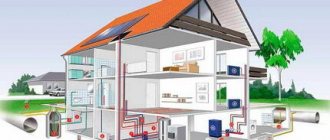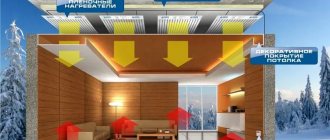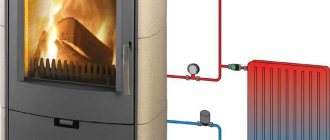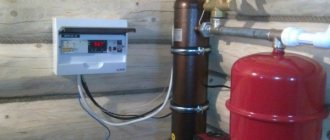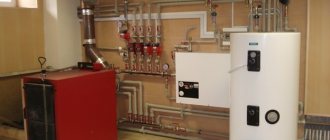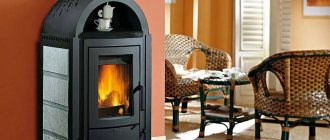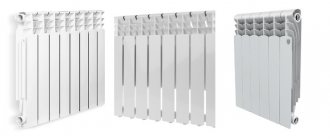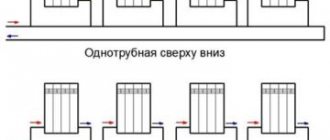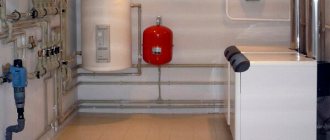Modern heating systems are equipped with a variety of equipment, which significantly increases the efficiency of heat transfer. The main trend of our time remains water heating convectors, which have a high efficiency, affordable price and stylish design. The listed advantages are enough to choose this option.
Efficiency is a “fat” advantage of this heating
Convection principle
The principle of operation of a convector battery
The principle of convection used in heating systems is that when cold air enters the zone of thermal radiation, it absorbs energy and warms up. At the same time, the air becomes lighter and rises while simultaneously transferring heat to other objects. The lack of constant contact with the source leads to a gradual cooling of the upper air layers. Because of this, they become heavier, sink down and come back into contact with the equipment that radiates heat.
This cycle is continuous as long as thermal energy is transmitted by the source. The intensity of the convection process can be increased using specialized equipment. The use of convector heating batteries as part of the system allows you to create a powerful directed air flow. They operate with consistently high efficiency and have excellent energy efficiency indicators.
Maximum operating temperature
| Parameter | Radiator Rifar Monolit | Convector TS CARNOT |
| Maximum operating temperature | 135°С | 110°C |
The radiator can handle higher temperatures. However, the question again arises - why? The maximum temperature circulating in the system in the most severe winter is 90 degrees. But let’s be honest, city utilities have not provided this temperature for a long time. The maximum is 80 degrees.
In new houses, this figure often does not even reach 60 degrees, and people are freezing due to the fault of management companies and operating organizations.
Pros and cons of convector radiators
Convector heaters are compact in size.
There are many arguments in favor of installing convector-type radiators.
- Simplicity and reliability of the design, which ensures long-term trouble-free operation of the equipment.
- Safety of use due to the relatively low surface temperature of the housing (in most cases the figure does not exceed +60 °C). But the temperature of the heated air can be significantly higher.
- Compact sizes. A convector radiator will take up no more space in the room than a more traditional steel or cast iron one. If necessary, you can choose a narrow model designed for installation under a low window.
- Ease of installation. To do this, just install the brackets, place the radiator on them and connect it to the heating source.
- Functionality. Manufacturers offer a wide selection of models, from which you can choose electronically controlled equipment. With its use, the user will be able to program the operation of the radiator and remotely adjust its parameters. Many models allow you to use an energy saving mode, which is especially relevant if the owners are away from home for a long time. For this purpose, the “Anti-freeze” mode is proposed, when turned on, the automation will maintain the temperature of the coolant at a level that will prevent the system from freezing.
The disadvantages of heaters include high energy consumption.
Before replacing previously installed radiators of a traditional design with convector heating devices, it is worth taking into account their disadvantages.
- High energy consumption: heating 10 m2 will require 1 kW/h.
- A significant difference between the temperature above and at floor level can cause discomfort. When choosing equipment whose design provides for the placement of outlet holes on the front wall, heating of the air layers will be more uniform.
- Low heating rate in the absence of a fan to force convection.
- In rooms with high ceiling heights, the use of convector heating is ineffective.
The constant movement of dust along with the movement of air in any case cannot have a positive effect on health. This problem may be especially relevant for young children or allergy sufferers.
Internal organization
A convector is a compact heating unit that operates on the basis of a physical process - convection, that is, the movement of air masses. The design is similar to a standard battery, but has a number of significant differences. The coolant supply pipes are connected using fittings; there is also a relief valve to remove air from the circuit. All convector water heating radiators must comply with a safety certificate.
A copper pipe is installed inside, which has a maximum heat transfer rate; aluminum fins are attached to it to increase the working area. The convector is designed in a compact design and fully complies with modern standards. Differences from battery:
- Convectors are available in forced and natural formats. In the first case, fans are installed to move air masses; in the second, air masses move themselves due to physical processes.
- Converter radiators are equipped with special sensors to regulate the temperature.
- Small size compared to cast iron batteries.
- A more presentable appearance, which cannot be said about outdated radiators.
In this video you will learn about installing heating in an apartment and installing Varmann in-floor convectors:
Modern water heating converter radiators are manufactured in accordance with safety requirements and customer needs. When choosing a suitable model, it is recommended to be guided by the area of the room, the presence of additional functions, and ease of use.
Types of convector equipment
Gas
Gas heating convector
When choosing a gas convector, the heating radiator will be connected to the central line. Installation of such equipment is possible only in gasified houses or if it is possible to connect to a liquefied gas cylinder. The complexity of installation and the need for approvals to install the unit are compensated by high rates of efficiency and energy efficiency.
Mermen
If you need to choose the cheapest convector to operate, a water-type battery is the ideal option. Depending on the design features of the existing heating system, you can choose a model with a bottom or side connection. Ease of operation is ensured by the installation of shut-off valves. Water units gain temperature fairly quickly, but are ineffective when used in rooms with high ceilings.
Electrical
Electric wall-mounted convector heater
Electric convectors stand out among their analogues in their ease of connection and operation, their ability to operate with an efficiency of up to 95% and a low noise level. As a rule, they are not equipped with fans. Among the disadvantages, it is worth highlighting significant energy consumption and increased utility bills. For higher efficiency, you can choose a model with a thermostat.
Center distance
| Parameter | Radiator Rifar Monolit | Convector TS CARNOT |
| Center distance | 80 mm - non-standard | 50 mm - standard |
Rifar radiators have come up with their own standard, which only fits their connection nodes. Convectors use standard components, similar for all manufacturers.
Rifar Radiator Assemblies
Standard components of the TS CARNOT convector
Calculation of the required number of radiators
To accurately determine the number of converter batteries needed to heat a room, many factors must be taken into account. First of all, the features of the building are taken into account: the material of the walls, the number of windows, their size, and the effectiveness of thermal insulation.
Accurate calculations are rarely made. In most cases, average indicators are used. In this case, the climatic features of the region matter.
For moderate latitudes, per 10 m2 of room area with a ceiling height of up to 3 m, 1 kW of heating unit power is sufficient. For northern regions, for example, for Yekaterinburg, this figure increases to 1.3 kW.
Right choice
The most important part begins with the selection of a suitable model. It is important not only to know where the convector will be mounted, but also whether it can provide heating in the required format. There are a sufficient number of technical parameters that are worth paying attention to:
- Thermal power. An indicator indicating the amount of power and heat required to heat a room of a certain area. It is worth noting that you need to add about 200 more watts for each window.
- Dimensions. Floor-mounted convectors require minimum dimensions, so this factor must also be taken into account. If a floor-standing model is required, then its dimensions are not particularly important.
- Moisture protection. There are separate models of convectors designed for use in the bathroom. The body of these systems has a special anti-corrosion coating, which prevents rusting.
- Ventilation. If it is necessary to create a thermal curtain in front of the window, then forced air exchange is required, and fans are installed in the convectors. Electricity is supplied via a 12 V power supply.
- Operating pressure. In an autonomous and central heating system, the pressure differs, so not every convector is suitable for use. It is recommended that you familiarize yourself with the technical specifications in advance.
- The volume of the thermal element. This is an indicator of how much coolant fits into the convector pipe. The higher this indicator, the more efficiently the heating system works.
- Automatic elements. Modern convector models are equipped with special temperature control sensors. It is enough to set a certain mode, and the automation will support it. For convenience, displays with buttons are built into the model.
- Limit temperature. The maximum temperature at which modern convectors operate is +120°C.
- Weight of equipment. It is clear that heavy convectors cannot be installed on plasterboard partitions. Therefore, the relevant technical parameters must be determined in advance.
Production of itermic water heating convectors:
Each factor is of great importance, and a responsible approach to selecting a convector will allow you to choose everything you need at affordable prices. Suitable heating equipment will perfectly heat the room and have a long service life.
Installation features
Water convectors
Installation and operation of heating equipment directly depends on the type and operating principle of the installed devices. When connecting a water radiator-convector, it is necessary to take into account the characteristics of the material from which it is made. The equipment is mounted on the wall using brackets. Special pipes are used to connect to the heating system and supply coolant. For joining, you can use steel or plastic pipes.
Installation of electrical equipment is much simpler and does not require the participation of specialists. Before installation, it is enough to take into account some safety rules. The distance to the floor should be more than 20 cm, to the outlet - from 35 cm, from the ceiling - from 55 cm, from the wall - less than 25 cm.
Self-installation is not permitted for gas units. Even a detailed study of information on specialized sites does not allow you to avoid errors, which is unacceptable from a security point of view.
Voting for the best convector
Which convector would you choose or recommend?
Alpine Air NGS-20 2.2 kW
16.67 % ( 1 )
Atem ZHYTOMYR-5 KNS-3
0.00 % ( 0 )
REDMOND SkyHeat 4526S
0.00 % ( 0 )
Electrolux ECH/B-1000 E
0.00 % ( 0 )
Noirot Spot E-5 1500
16.67 % ( 1 )
Electrolux ECH/AGI-1500
0.00 % ( 0 )
Nobo NFK 4W 20
0.00 % ( 0 )
Electrolux ECH/R-1500 T
33.33 % ( 2 )
Timberk TEC.E3 M 2000
16.67 % ( 1 )
Stiebel Eltron CNS 50 S
0.00 % ( 0 )
ENSTO EPHBMM07PR
16.67 % ( 1 )
Ballu Camino Eco Turbo BEC/EMT-1500
0.00 % ( 0 )
Price
| Parameter | Radiator Rifar Monolit | Convector TS CARNOT |
| Price | RUB 11,480 | RUB 21,380 |
| Cost of fasteners | 280 rub. | included |
The price difference is 9,620 rubles in favor of the radiator. Therefore, if the goal is maximum savings, a radiator, without a doubt, will be a suitable solution to the heating problem.
Wooden convector hidden in the floor, TS CARNOT
However, if a modern, beautiful and safe heating method is important to you, the choice is yours! In the following articles, we will talk in detail about the various models of convectors and methods for selecting them.
Paint colors
| Parameter | Radiator Rifar Monolit | Convector TS CARNOT |
| Paint color | Only white | Any according to RAL |
Radiators come from the factory exclusively in the standard white color.
Convectors can be painted in any color without increasing the cost, thereby solving the problems of interior design of the room. The color can be selected from more than 220 different shades.
Various color options for TS CARNOT convectors
In both cases, safe to use and durable powder coating is used.
How to reduce heating costs
We have written more than once that reducing heat losses helps make electric heating cheaper. How to reduce heating costs? Here are the basic steps to help reduce your energy costs:
The main indicators of heat loss in private houses. If you insulate the walls, floor and attic, as well as install good windows and doors, you will save significantly on heating.
- insulation of doors - if your house has uninsulated doors, feel free to throw them in the trash. Spend some money and buy a normal door with good thermal insulation;
- triple glazed windows will help reduce heat loss by about 10% . Heat loss is also reduced by reducing the area of window openings. This isn't always possible, but you can simply brick up a couple of unnecessary windows;
- insulating the attic will provide another 5-10 percent savings;
- creating additional thermal insulation of walls - for example, by covering a house made of a cement block with bricks and mineral wool, you will get significant savings.
Some of these tips are easiest to implement at the stage of building a home - do not create too wide window openings and once again review the number of windows, provide insulation with mineral wool or other thermal insulation, think about insulating the attic, immediately order triple energy-saving double-glazed windows.
